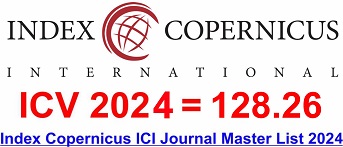Effectiveness of Pre-Clinical Delivery of Behaviour Modelling Training Method to Improve Caring of Nursing Students
DOI:
https://doi.org/10.31674/mjn.2025.v16i04.022Abstract
Background: Caring behaviour is not only carried out by nurses but is also carried out by nursing students at the service practice stage in hospitals as the first place to learn about the values and nature of their profession. Objective: The aim of this research is to analyse the effectiveness of preclinical debriefing using a behaviour modelling training model for nursing students to find basic strategies that can improve Caring behaviour in carrying out clinical practice in health services. Methods: This research includes pre-experimental research with a One Group Pretest-Post-test approach. The research subjects 27 level 1 nursing students.The collected data was processed statistically using the T test, a related analysis technique. Results: The statistical tests show significant differences between pre-test and post-test scores. For self-efficacy, the pre-test average was 17.89, increasing to 25.26 in the post-test (an increase of 7.37), with a t value of 32.660 and a p-value of 0.000 for clinical knowledge. For emotional regulation, the pre-test average was 10.22, rising to 14.22 (an increase of 4.00), with a t value of 39.618 and a p-value of 0.000. Both results indicate significant differences (p < 0.05). Conclusion: The behaviour modelling training method has been proven to be applicable as a training model because it has a clear syntax for changing participant behaviour according to the expected goals.
Keywords:
Behaviour Modelling Training, Caring, Pre-ClinicDownloads
References
Abawaji, M. A., Cardwell, R., & McKenna, L. (2024). Missed nursing care among nursing students: A scoping review. Nurse Education Today, 137. https://doi.org/10.1016/J.NEDT.2024.106169
Akgün, M., Kavradim, S. T., Boz, İ., & Özer, Z. (2020). Development and psychometric properties of the Caring Behaviors Assessment Tool Nursing Version-Short Form. International Journal for Quality in Health Care, 32(10), 701–707. https://doi.org/10.1093/intqhc/mzaa134
American Academy of Addiction Psychiatry & American Society of Addiction Medicine. (2024). The ASAM/AAAP clinical practice guideline on the management of stimulant use disorder. Retrieved from: https://www.aaap.org/education/management-of-stimulant-use-disorder-guideline/. Accessed on 15h February, 2024.
Anshori, M., & Iswati, S. (2020). Qualitative research methodology. 1st Edition, Airlangga University Press. Indonesia. Retrieved from : https://books.google.co.id/books?id=ltq0DwAAQBAJ&printsec=copyright&hl=id#v=onepage&q&f=false. Accessed on 28th March, 2024.
Arliman, L., Arif, E., & Sarmiati. (2022). (2022). Pendidikan Karakter Untuk Mengatasi Degradasi Moral Komunikasi Keluarga [Character education to overcome moral degradation family communication]. Ensiklopedia of Journal, 4(2), 143–149. https://doi.org/10.33559/EOJ.V4I2.1056
Ayaz-Alkaya, S., & Terzi, H. (2022). Predictors of attitudes towards nursing profession and peer caring behaviors of the nursing students: A cross-sectional study. Nurse Education Today, 116. https://doi.org/10.1016/J.NEDT.2022.105467
Bandura, A. (1977). Self-efficacy: Toward a unifying theory of behavioral change. Psychological Review, 84(2), 191–215. https://doi.org/10.1037/0033-295X.84.2.191
Fenizia, E., Navarini, L., Scollo, S., Gambera, A., & Ciccozzi, M. (2020). A longitudinal study on caring behaviors of Italian nursing students. Nurse Education Today, 88. https://doi.org/10.1016/J.NEDT.2020.104377
Field-Richards, S. E., Aubeeluck, A., Callaghan, P., Keeley, P., Redsell, S. A., Spiby, H., Stacey, G., & Lymn, J. S. (2024). The impact of prior care experience on nursing students’ compassionate values and behaviours: A mixed methods study. International Journal of Nursing Studies, 153. https://doi.org/10.1016/J.IJNURSTU.2024.104732
Garcia, D., Kazemitabar, M., Björk, E., Daniele, T. M. da C., Mihailovic, M., Cloninger, K. M., Frota, M. A., & Cloninger, C. R. (2024). Nursing students’ personality (Temperament and Character), burnout symptoms, and health and well-being. International Journal of Nursing Studies Advances, 6. https://doi.org/10.1016/J.IJNSA.2024.100206
Gonzalo, A. (2024, April 30). Jean Watson: Theory of human caring. Nurseslabs. Retrieved from: https://nurseslabs.com/jean-watsons-philosophy-theory-transpersonal-caring/. Accessed on 28th March, 2024.
Harjanto, T., & Sumunar, D. S. E. W. (2018). Tantangan Dan Peluang Pembelajaran Dalam Jaringan: Studi Kasus Implementas Elok (E-Learning: Open for Knowledge Sharing) Pada Mahasiswa Profesi Ners [Challenges and Opportunities for Online Learning: A Case Study of Elok's Implementation (E-Learning: Open for Knowledge Sharing) for Nursing Professional Students]. Jurnal Keperawatan Respati Yogyakarta, 5, 24–28. https://doi.org/10.35842/jkry.v5i0.282
Honkavuo, L. (2019). Nursing students’ perspective on a caring relationship in clinical supervision. Journal of Research in Nursing, 27(5), 1225–1237. https://doi.org/10.1177/0969733019871695
Hopstock, L. A. (2008). Motivation and adult learning: A survey among hospital personnel attending a CPR course. Resuscitation, 76(3), 425–430. https://doi.org/10.1016/J.RESUSCITATION.2007.09.011
Jannah, N., Fitrisia, D., Fitriani, S. S., & Safira, R. Y. (2022). Nursing students’ attitude towards problem-based learning in the classroom. Enfermería Clínica, 32, S24–S29. https://doi.org/10.1016/J.ENFCLI.2022.03.012
Jiang, J., Liu, Y., Han, P., Zhao, J., Shi, Y., & Zhuang, Y. (2024). Perceptions and experiences of Generation Z nursing students during their practicum in an intensive care unit: A qualitative study. Heliyon, 10(4), 1-9. https://doi.org/10.1016/J.HELIYON.2024.E26205
Katayama, H., Muramatsu, T., Aoki, Y., & Nagashima, E. (2022). Psychometric evaluation of the Ethical Caring Competency Scale in nursing. BMC Nursing, 21. https://doi.org/10.1186/s12912-022-00886-2
Kereh, H. F., & Rochmawati, E. (2022). Pengalaman Belajar Mahasiswa Keperawatan dalam Praktik Klinik [Nursing students' learning experience in clinical practice]. Journal of Telenursing (JOTING), 4(1), 279–288. https://doi.org/10.31539/JOTING.V4I1.2745
Kol, E., Ince, S., Işik, R. D., Ilaslan, E., & Mamakli, S. (2021). The effect of using standardized patients in the Simulated Hospital Environment on first-year nursing students psychomotor skills learning. Nurse Education Today, 107. https://doi.org/10.1016/J.NEDT.2021.105147
Lundell Rudberg, S., Westerbotn, M., Scheja, M., & Lachmann, H. (2022). Views on education and upcoming profession among newly admitted students at a Swedish baccalaureate nursing program: A descriptive mixed method study. Nurse Education in Practice, 63. https://doi.org/10.1016/j.nepr.2022.103393
Nurhayati, N. (2018). Model Peningkatan Perilaku Caring pada Mahasiswa Jurusan Keperawatan Politeknik Kesehatan Kemenkes Pangkalpinang [Improving Caring Behavior in Nursing Students of the Pangkalpinang Ministry of Health Polytechnic]. Jurnal Kesehatan, 9(2), 225–232. https://doi.org/10.26630/JK.V9I2.775
Rozani, V., Zur-Peled, S., & Aharon, A. A. (2024). Caring for people with intellectual disabilities: Insights from a cross-sectional study among nursing students. Nurse Education Today, 138. https://doi.org/10.1016/J.NEDT.2024.106187
Rutten, J. E. R., Heijligers, E., Erkens, P., Backhaus, R., Hamers, J. P. H., Verbeek, H., & Sion, K. Y. J. (2024). Students’ experiences with a hybrid learning environment in nursing homes: A qualitative study. Nurse Education in Practice, 79, 1-7. https://doi.org/10.1016/J.NEPR.2024.104078
Saghafi, F., Blakey, N., Guinea, S., & Levett-Jones, T. (2024). Effectiveness of simulation in nursing students’ critical thinking scores: a pre-/post-test study. Clinical Simulation in Nursing, 89, 1-8. https://doi.org/10.1016/J.ECNS.2023.101500
Setiadi, A., Muhari, B., Roesminingsih, E., & Irawandi, D. (2020). Caring behaviour education model for nursing students. International Journal of Innovation, Creativity and Change, 12(6), 376–394. Retrieved from: https://doi.org/10.1515/ijnes-2019-0072, Accessed on 25th March, 2024.
Syed, S. A., Zafar, S. S., Syed, F. A., Iqbal, A., & Atif, S. (2024). Comparison of light microscopy and digital microscopy for learning oral pathology practicals among second year dental students. Journal of Dental Sciences, 19(4), 2135–2139. https://doi.org/10.1016/J.JDS.2024.03.022
Tian, X., Zheng, X., Peng, Y., Zhou, X., Huang, B., Xie, Y., & Xiao, W. (2024). The effects of hospice care education on first-year undergraduate nursing students in mainland China: A mixed-methods study. Nurse Education Today, 134. https://doi.org/10.1016/J.NEDT.2024.106095
Watson, J. (1997). The theory of human caring: Retrospective and prospective. Nursing Science Quarterly, 10(1), 49-52. https://doi.org/10.1177/089431849701000114
Yeng Lau, K., Keng Chan, S., Le Cheah, L., Abdul Jabbar, A. B., & Hoon Lim, S. (2024). Experiences of preceptorship in Singapore: A qualitative exploratory study of preceptors’ experience in precepting nursing students during pre-registration of clinical placement in an acute hospital. Nurse Education in Practice, 75. https://doi.org/10.1016/J.NEPR.2024.103875
Published
How to Cite
Issue
Section
License
Copyright (c) 2025 The Malaysian Journal of Nursing (MJN)

This work is licensed under a Creative Commons Attribution-NonCommercial-NoDerivatives 4.0 International License.



































